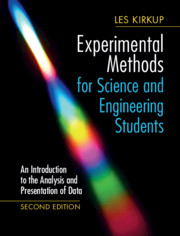 Experimental Methods for Science and Engineering Students
Experimental Methods for Science and Engineering Students Published online by Cambridge University Press: 24 August 2019
No matter how much care is taken during an experiment, or how sophisticated the equipment used, values obtained through measurement are influenced by errors. Errors can be thought of as acting to conceal the true value of the quantity sought through experiment. Random errors cause values obtained through measurement to occur above and below the true value. This chapter considers statistically-based methods for dealing with variability in experimental data such as that caused by random errors. As statistics can be described as the science of assembling, organising and interpreting numerical data, it is an ideal tool for assisting in the analysis of experimental data.
To save this book to your Kindle, first ensure [email protected] is added to your Approved Personal Document E-mail List under your Personal Document Settings on the Manage Your Content and Devices page of your Amazon account. Then enter the ‘name’ part of your Kindle email address below. Find out more about saving to your Kindle.
Note you can select to save to either the @free.kindle.com or @kindle.com variations. ‘@free.kindle.com’ emails are free but can only be saved to your device when it is connected to wi-fi. ‘@kindle.com’ emails can be delivered even when you are not connected to wi-fi, but note that service fees apply.
Find out more about the Kindle Personal Document Service.
To save content items to your account, please confirm that you agree to abide by our usage policies. If this is the first time you use this feature, you will be asked to authorise Cambridge Core to connect with your account. Find out more about saving content to Dropbox.
To save content items to your account, please confirm that you agree to abide by our usage policies. If this is the first time you use this feature, you will be asked to authorise Cambridge Core to connect with your account. Find out more about saving content to Google Drive.